In 2025, raising investment requires flexibility, given the competitive shift in fundraising. While there is availability of diverse options for funding including equity rounds, SAFEs (Simple Agreements for Future Equity), and convertible notes, founders must choose what best fits their needs strategically. Convertible notes remain a popular choice among early-stage startups, favored by over 55% due to their flexibility and speed. At spectup, we believe that these instruments act as a vital bridge between debt and equity financing, allowing startups to raise capital quickly while deferring complex valuation discussions.
However, it was observed that the issuance of convertible instruments like SAFEs and convertible notes declined with the decrease in Pre-seed funding. This particularly emphasizes the tighter scrutiny and enhanced disciplinary measures while deploying capital. While convertible notes simplify execution, there are challenges for founders to clearly communicate terms and manage investor expectations. Therefore, while considering the funding climate that demands sharper precision and speed, Spectup equips startups with tailored support to raise smarter, face these hurdles, and implement strategic tools to maintain momentum.
What Is a Convertible Note?
For Early stage funding instruments, convertible notes are like the Swiss Army knife of startup financing. It functions as a debt that’s ready to transform, starting off as a loan, but with the option of conversion into equity upon reaching the significant financial milestone. Thus, making convertible notes popular among founders and investors who want to keep things simple and flexible until the company’s valuation becomes clearer.
A convertible note is a type of promissory note that outlines the terms of the loan, including the maturity date, which is when the note is due to be repaid or converted into equity. Notable investors such as Y Combinator, Sequoia Capital, and First Round Capital frequently use convertible notes as part of their early stage funding instruments to finance startups, allowing for greater flexibility and simplicity in the investment process. By deferring valuation discussions, convertible notes provide both founders and investors with a pragmatic approach to bridge funding, allowing startups to focus on growth while securing critical capital.
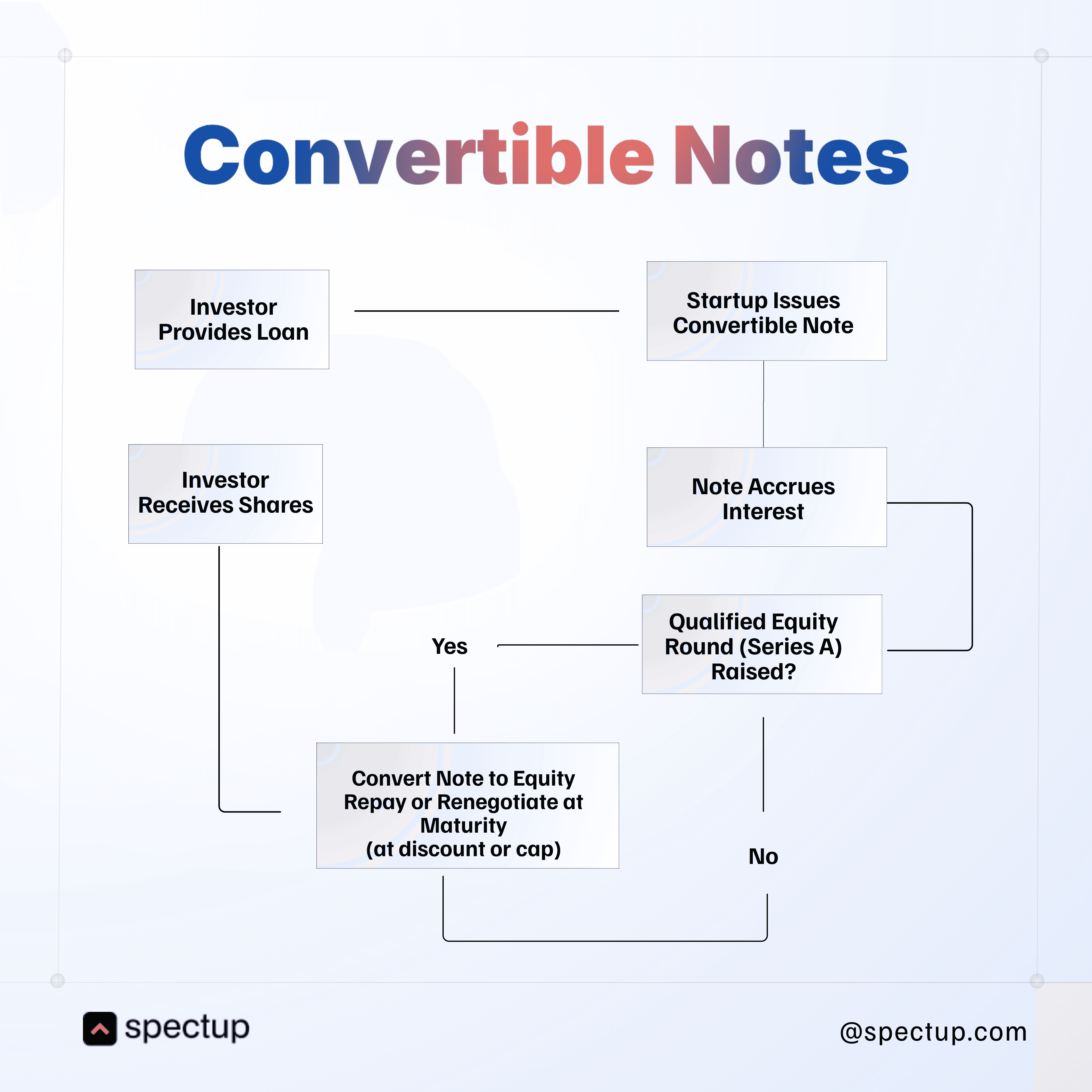
Key Features of Convertible Notes
Debt-based instrument: Initially, a convertible note acts like a loan for the startup. Investors handover the cash upfront, and the startup owes them the relevant amount, but it’s not just any loan.
Conversion trigger: When the startup raises a qualified financing round (usually Series A), the note automatically converts into shares of the startup at a specified conversion price. Thus referring to the fact that investors swap debt for ownership.
Discount rate: To reward early-stage investors for taking on higher risk, convertible notes typically allow them to purchase shares at a discounted price relative to new investors participating in the subsequent financing round.
Valuation cap: This holds the pivotal point that sets a maximum valuation for conversion purposes. Even if the startup’s worth skyrockets in the next equity financing round, early investors won’t get diluted unfairly, instead they convert as if the valuation never exceeded this cap.
Interest rate: Some convertible notes accrue interest over time, which increases the total investment amount prior to conversion. This feature allows investors to earn additional value on their initial loan while awaiting the qualifying financing event.
Maturity date: The maturity date is crucial in convertible note agreements; it defines the timeline for conversion or repayment. If the note hasn't been converted by this date and another financing round hasn’t occurred, the startup may be required to repay the invested amount, ensuring that investors are protected even if growth stalls.
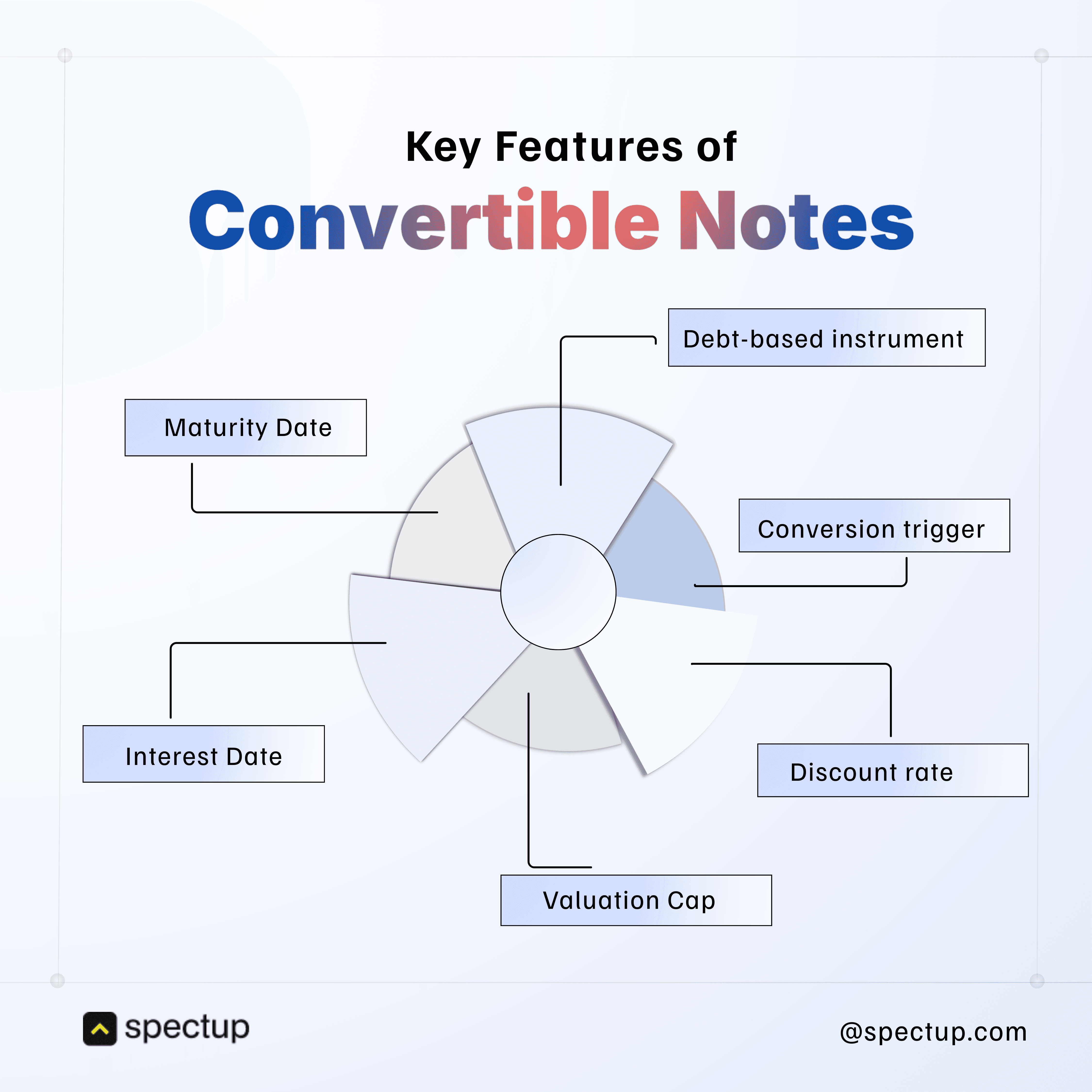
Understanding how convertible notes work can give startup founders a solid footing when navigating fundraising options, especially compared to other tools like SAFEs.
How Convertible Notes Work in Practice?
Convertible notes are a popular choice among early-stage funding instruments due to their blend of simplicity and flexibility. To understand how these convertible debt tools function from inception to conversion, it is useful to examine the typical lifecycle.
Typical Lifecycle of a Convertible Note
Initial Investment: An investor provides a loan to the startup under agreed terms, which typically include the principal amount, interest rate, valuation cap, discount rate, and maturity date. At this stage, no equity or valuation is issued; instead, the note represents a promise to convert to shares later. For Investors Card provides access to a curated selection of early-stage and high-potential startups raising funds.
Note accrues interest (if applicable). Some convertible notes build up interest over time, adding to the amount that will convert later.
Conversion Trigger: When the startup raises its next priced round (like Series A), the loan turns into equity based on agreed terms, usually involving discounts or valuation caps. The terms ensure that early-stage investors receive favorable pricing compared to new investors.
Maturity: In some cases, where no conversion event occurs by the maturity date, provisions may allow the investor to convert at a default valuation, extend the note, or potentially request repayment, although cash repayment is uncommon.
Example Scenario
Imagine a startup raises $500,000 using convertible notes that come with a 20% discount and a $5 million valuation cap. Later on, the company completes its Series A funding at a $10 million valuation. When it’s time to convert the notes into shares, investors have two options: they can either get a 20% discount on the $10 million valuation, meaning their shares are priced as if the company were worth $8 million or they can use the $5 million valuation cap.
Because the $5 million cap gives them shares at an even lower price than the discounted $8 million, investors choose to convert their notes at this capped valuation. This means they get more shares for their money. This example shows how valuation caps benefit early investors by giving them extra upside for taking on more risk early in the company’s journey.
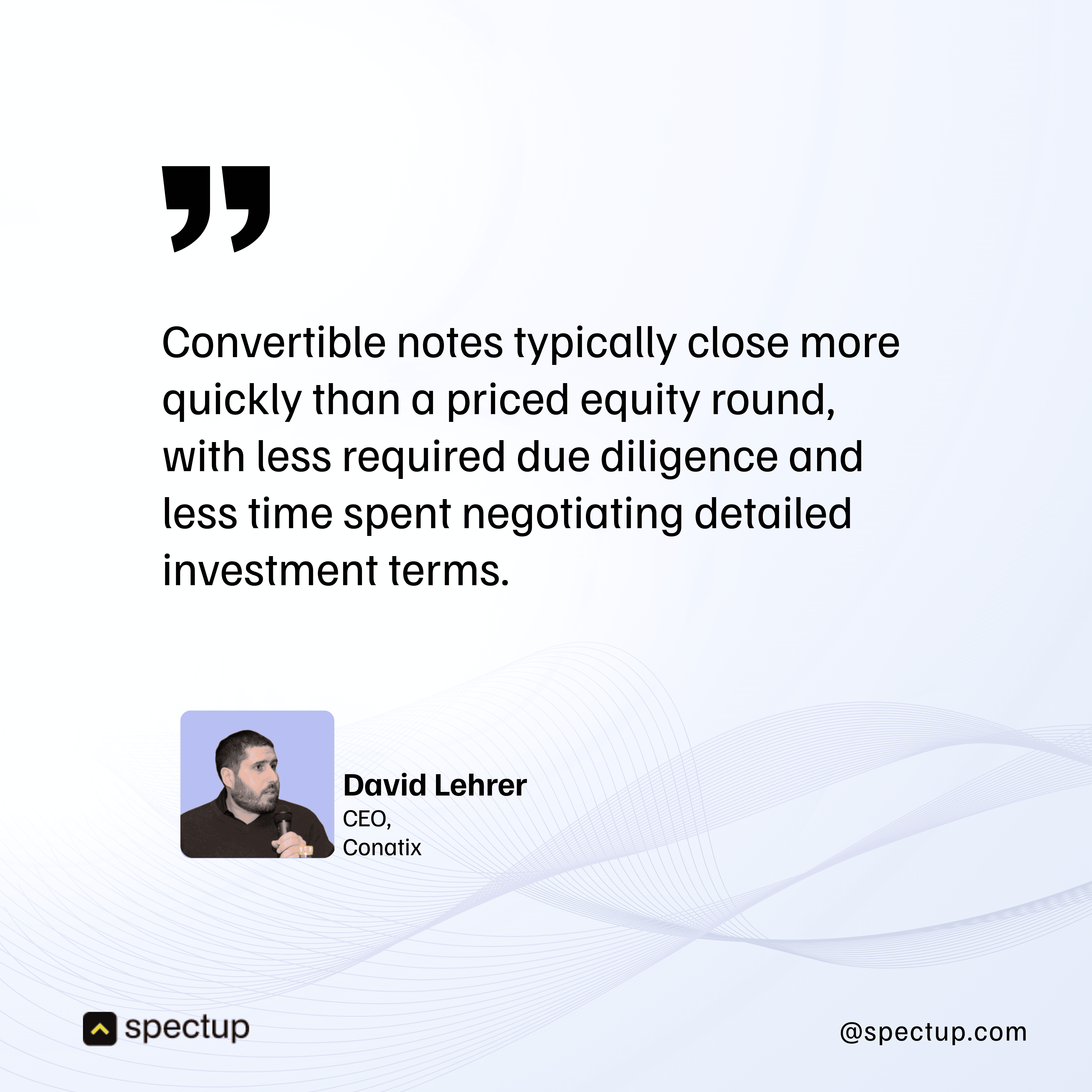
Understanding these conversion mechanisms is essential for founders managing their cap tables and evaluating financing instruments like convertible note vs SAFE agreements. Clear comprehension of discount rates, valuation caps, and conversion triggers can prevent complications during fundraising and equity allocation.
Many successful companies like Airbnb and Dropbox utilized convertible notes in their early funding rounds to attract investors while offering flexibility in valuation. Examples of successful funding journeys and real-world impact can be found in spectup’s case studies, which detail how we have supported startups and investors throughout the entire fundraising process. These stories demonstrate practical results and strategic execution in diverse market conditions.
Convertible Notes vs Other Early Stage Funding Instruments
In 2025, convertible notes continue to hold a crucial place in the early stage funding landscape as a versatile bridge between SAFEs and priced equity rounds. Market trends show startups gravitating toward instruments that balance speed, simplicity, and investor protections. Convertible notes deliver on this by deferring valuation discussions and providing downside safeguards through interest and valuation caps, features that SAFEs typically lack.
While SAFEs have surged in popularity, especially in hot sectors like AI for their ease and low legal costs, many investors remain wary of the weaker legal protections and lack of maturity dates. On the other hand, priced equity rounds offer governance and clarity but demand heavier diligence and longer timelines, often making them a less attractive option during uncertain pre-seed or seed phases
Over 55% of early-stage startups now choose convertible notes as their preferred funding instrument due to their flexibility and investor-friendly discount rates. Convertible notes allow startups to delay formal valuation while securing capital quickly.
Pre-seed startups in the US raised about $737 million across 5,119 convertible instruments in Q1 2025, which is a decline from Q4 2024's $923 million across 6,251 instruments.
Smaller rounds under $1 million have become more common while larger rounds have decreased.
Median raise amounts for convertible notes in bridge or post-seed rounds increased to about $2.5 million in Q1 2025, showing investor willingness to participate in bridge rounds amid uncertain markets.
Market data shows a shift toward SAFEs at the early pre-seed stage, while convertible notes remain strong in post-seed bridge rounds, reflecting changing investor strategies and risk appetite. Despite a dip in overall pre-seed deal volume and convertible instrument issuance in early 2025, founders using convertible notes are able to close rounds faster and with less friction, navigating a cautious market with strategic agility.
At Spectup, we help startups make these nuanced choices, tailoring funding strategies that align with their unique growth trajectories and investor expectations, because early-stage financing is never one size fits all.
Understanding Early Stage Funding Instruments
Understanding the difference between a convertible note and a SAFE (Simple Agreement for Future Equity) along with convertible debt funding is crucial in early-stage funding to avoid future complications. Both are used to raise capital before a company’s valuation is set, but they differ significantly in structure and implications.
A convertible note is a debt instrument: the company receives funds that accrue interest and must convert to equity or be repaid by a maturity date. Upon a qualified financing round, it converts into shares, often at a discount or with a valuation cap. Convertible notes offer investors stronger legal protections since they are enforceable as debt if conversion fails.
A SAFE is not a loan but an agreement granting investors future equity without interest or repayment deadlines. SAFEs are simpler and cheaper to administer, don’t require repayment, and involve streamlined documentation. However, they provide fewer legal protections for investors compared to convertible notes.
Convertible debt starts as a loan with terms including an interest rate, maturity date, valuation cap, and discount rate. The investor’s loan accrues interest and must be repaid or converted into shares by the maturity date. When the startup completes a qualifying equity round, the note converts into stock, usually at a discount or capped valuation, rewarding early investors for the risk taken.
Convertible Debt Funding vs Convertible Notes:
Convertible debt funding is a financing structure where an investor provides a loan to a startup that converts into equity at a future financing round. A convertible note is the specific legal instrument used to document this agreement. In other words, convertible notes are the signed contracts that implement convertible debt funding.
While convertible debt is the concept, the convertible note is the actual promissory note defining the terms. They are often used interchangeably in startup fundraising conversations because the note is the most common form of convertible debt.
Key points of distinction:
Convertible debt is the funding concept: loan that converts to equity later.
Convertible note is the legal document: the promissory note governing that loan and conversion.
Both create a hybrid debt-equity instrument that helps startups raise capital quickly without immediate valuation negotiations, but the note contains all the binding terms for interest, maturity, conversion triggers, caps, and discounts. Convertible notes are the contractual vehicle for executing convertible debt funding in startups, making the two terms closely linked but not exactly the same
Convertible debt is especially useful when you need bridge funding between equity rounds or want to close deals quickly with minimal negotiation.
Convertible notes have been widely adopted in Silicon Valley since the early 2000s, helping countless startups secure vital runway without complex negotiations over valuation
Convertible Notes vs SAFE Agreements
Convertible Notes:
When investors want legal protections or require bridge financing.
In situations where a maturity date enforces discipline on future fundraising.
SAFEs:
Ideal for very early-stage rounds with friendly angel investors.
If you want quick, low-cost funding without adding debt pressure.
A common consideration for startups is determining which financing instrument aligns best with current operational needs. Understanding the practical differences between convertible notes and SAFEs enables founders to select the most appropriate option, thereby maintaining a streamlined capitalization table and supporting ongoing growth objectives.
Knowing these distinctions helps founders and investors select the best financing option based on their needs and risk tolerance.
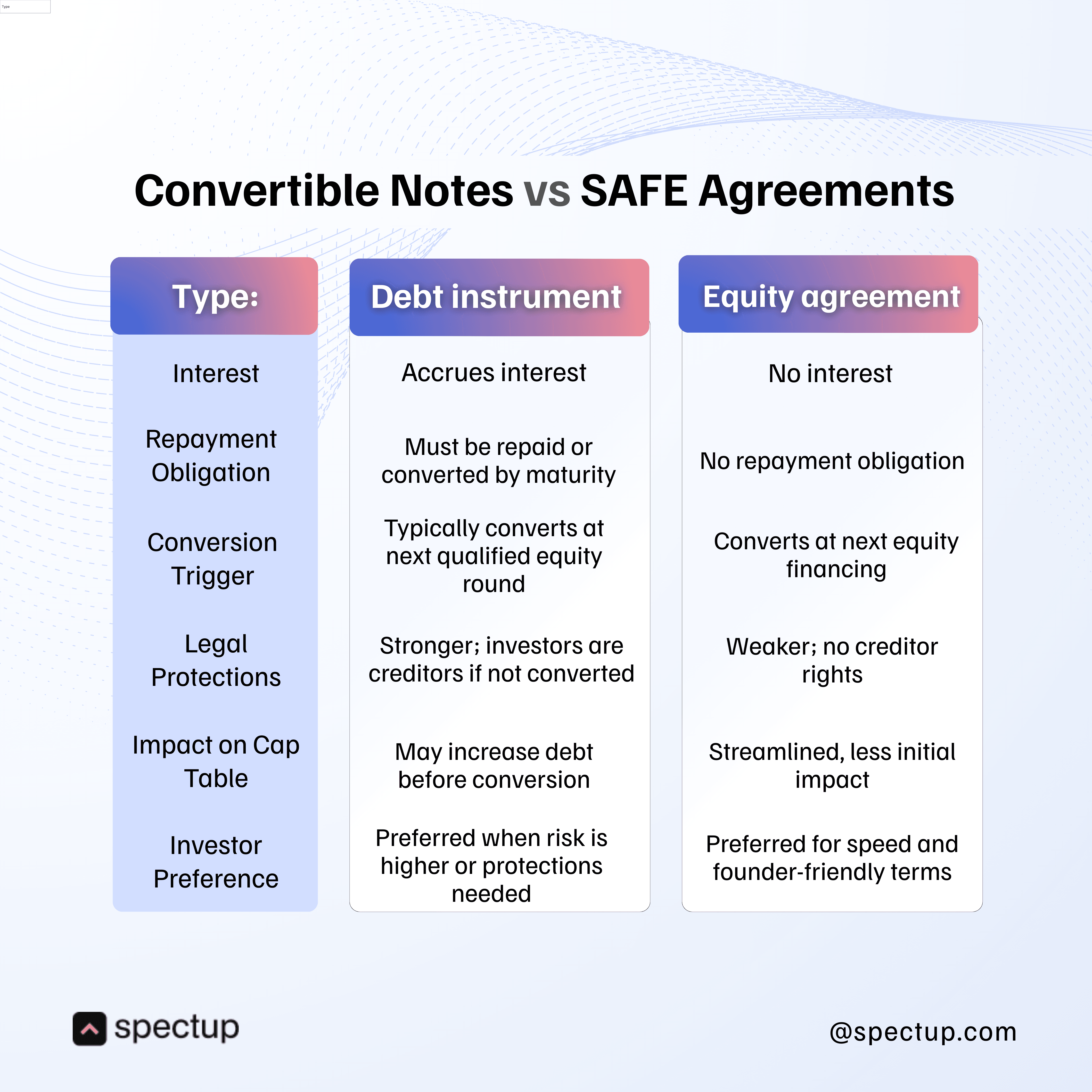
Advantages of Convertible Notes for Startups
Convertible notes distinguish themselves among early-stage funding instruments by combining simplicity with flexibility. Their appeal lies primarily in how they address the often complex challenge of valuation while expediting the fundraising process.
Unlike traditional equity rounds, which require immediate valuation negotiations that can be difficult for startups still in early development, convertible notes effectively defer valuation discussions until a subsequent priced financing round. This deferral provides startups with the necessary runway to grow, validate their business model, and achieve a stronger market position before determining equity value.
Here’s a quick look at why convertible debt funding shines for startups:
Avoids immediate valuation negotiations: You don’t have to argue over what your company is worth in its infancy. The note converts later based on a future valuation event, simplifying the startup equity conversion process.
Faster and cheaper to execute than priced equity rounds: Legal paperwork is lighter, closing times shorten, and fundraising costs shrink, reducing legal fees for startup funding, so you keep more energy (and cash) for building.
Attracts investors by offering discounts and caps: Discount rates and valuation caps sweeten the deal, rewarding early backers with better share prices compared to later investors.
Delays dilution until future financing: Since conversion happens later, founders hold onto more ownership upfront while still raising much-needed capital, effectively utilizing delayed dilution.
Provides bridge funding between rounds: Convertible notes serve as an ideal bridge when you're not quite ready for a full equity round but need cash to hit milestones.
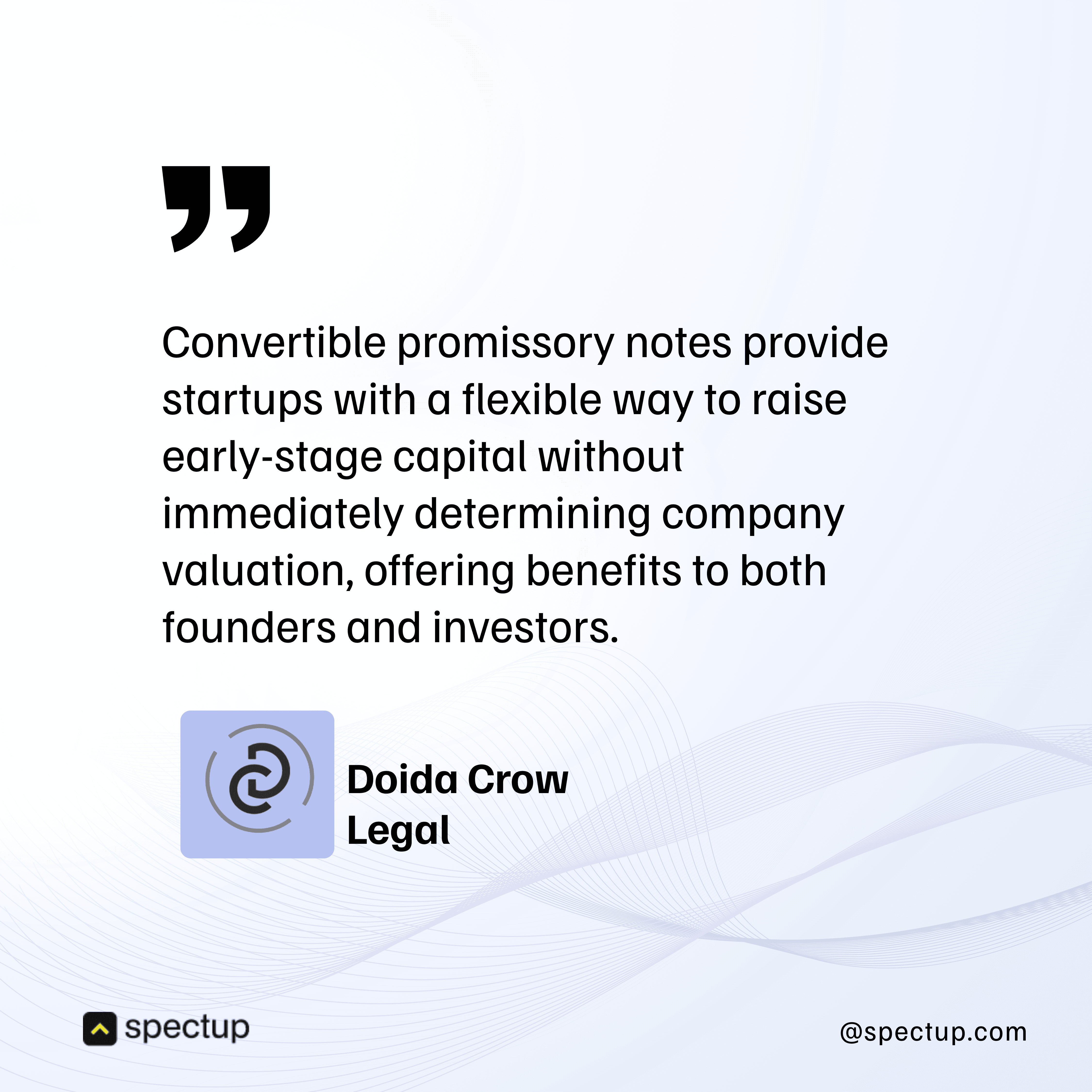
Understanding how convertible notes work including their impact on your convertible note cap table can help you plan smarter fundraising strategies. It’s not just about raising money, instead it’s about doing so on terms that support your startup’s growth trajectory without getting bogged down in complex negotiations right out of the gate.
This flexibility explains why many founders favor convertible notes over other instruments like SAFEs or priced rounds during those crucial early days.
Risks and Challenges of Convertible Notes
Convertible notes are frequently utilized as a rapid funding mechanism for early-stage startups. While their perceived speed and simplicity can be appealing, it is essential to recognize the inherent risks before proceeding. A thorough understanding of these challenges is crucial, particularly when managing complex components such as convertible note mechanics and maintaining an accurate convertible note cap table. The following outlines key considerations to mitigate potential issues for both founders and investors:
Accrued Interest Leading to Increased Dilution: Convertible notes typically accrue interest until the point of conversion. Although the interest rate may appear minimal initially, accrued interest is added to the principal amount upon conversion into equity. This results in a larger share allocation than originally anticipated, thereby increasing dilution of founders’ ownership.
Cap Table Complexity Due to Mismanaged Notes: Convertible notes often feature varying terms, including different discounts, valuation caps, and interest rates. Inadequate tracking or documentation can result in a complicated cap table, making it difficult to accurately forecast ownership distributions and complicating subsequent fundraising efforts.
Potential Investor Conflicts from Large Note Rounds: When multiple investors hold significant convertible notes with differing terms, conflicts may arise at the time of conversion. Divergent interests such as preferences for earlier exits versus higher valuations can lead to disagreements that detract from operational focus and business growth.
Maturity Dates Creating Pressure for Premature Fundraising: As debt instruments, convertible notes have specified maturity dates by which repayment or conversion must occur. If a startup fails to secure a priced equity round before this date, it may be compelled either to repay the note or renegotiate terms, both of which can be detrimental for companies still in early development stages.
A comprehensive evaluation of these risks enables more informed decision-making when selecting between convertible debt funding, Simple Agreements for Future Equity (SAFEs), or alternative early-stage financing options. Prioritizing long-term stability over short-term convenience is essential for sustaining startup growth and resilience.
Impact of Convertible Notes on the Cap Table
Convertible notes serve a distinct function in the structuring of a startup’s capitalization table (cap table). Unlike traditional priced equity rounds, convertible notes are initially structured as debt instruments and subsequently convert into equity at a later financing event. This conversion generally occurs at a discounted share price or pursuant to a predefined valuation cap, enabling early investors to acquire more shares for their investment than new participants in subsequent funding rounds. As a result, the conversion of these notes can significantly alter the composition of the cap table.
Cap Table Considerations
Impact of Discounts and Valuation Caps: Convertible notes typically convert into equity at a share price below that established in the Series A round, either through an explicit discount rate or by applying a valuation cap. This mechanism often results in note holders receiving a greater number of shares relative to their original investment amount.
Complexity from Multiple Notes: The issuance of multiple convertible notes, each with varying terms such as different caps, discounts, or interest rates, can significantly complicate the conversion process. Accurate tracking and meticulous record-keeping are essential to determine the exact number of shares allocated to each investor.
Risks of Inadequate Modeling: Founders who do not conduct thorough conversion scenario analyses may experience unexpected levels of dilution during the Series A round. This lack of preparation can adversely affect ownership percentages and potentially diminish founders’ control over the company.
Post-money valuation denotes the value of the company immediately following the receipt of new investment capital, while pre-money valuation represents its assessed worth prior to that investment. These valuations are critical in post-conversion cap table management, as they directly influence both the share price offered to new investors and the distribution of ownership among all shareholders. Specifically:
A higher post-money valuation typically results in convertible note holders receiving fewer shares upon conversion.
Conversely, a lower pre-money valuation increases dilution for existing shareholders by allocating a larger portion of equity to convertible note holders.
Accurate modeling and ongoing cap table management are therefore essential for maintaining transparency and ensuring informed decision-making throughout successive funding rounds.
Best Practices
Model Dilution Scenarios Early: Use spreadsheets or software tools to simulate how different note conversions affect ownership stakes under various fundraising outcomes.
Standardize Terms When Possible: Having consistent caps, discounts, and maturity dates across your convertible note investors simplifies calculations and avoids disputes.
Leverage Cap Table Management Software: Tools like Carta or Capshare help keep your capitalization structure transparent and updated as convertible debt funding converts into equity.
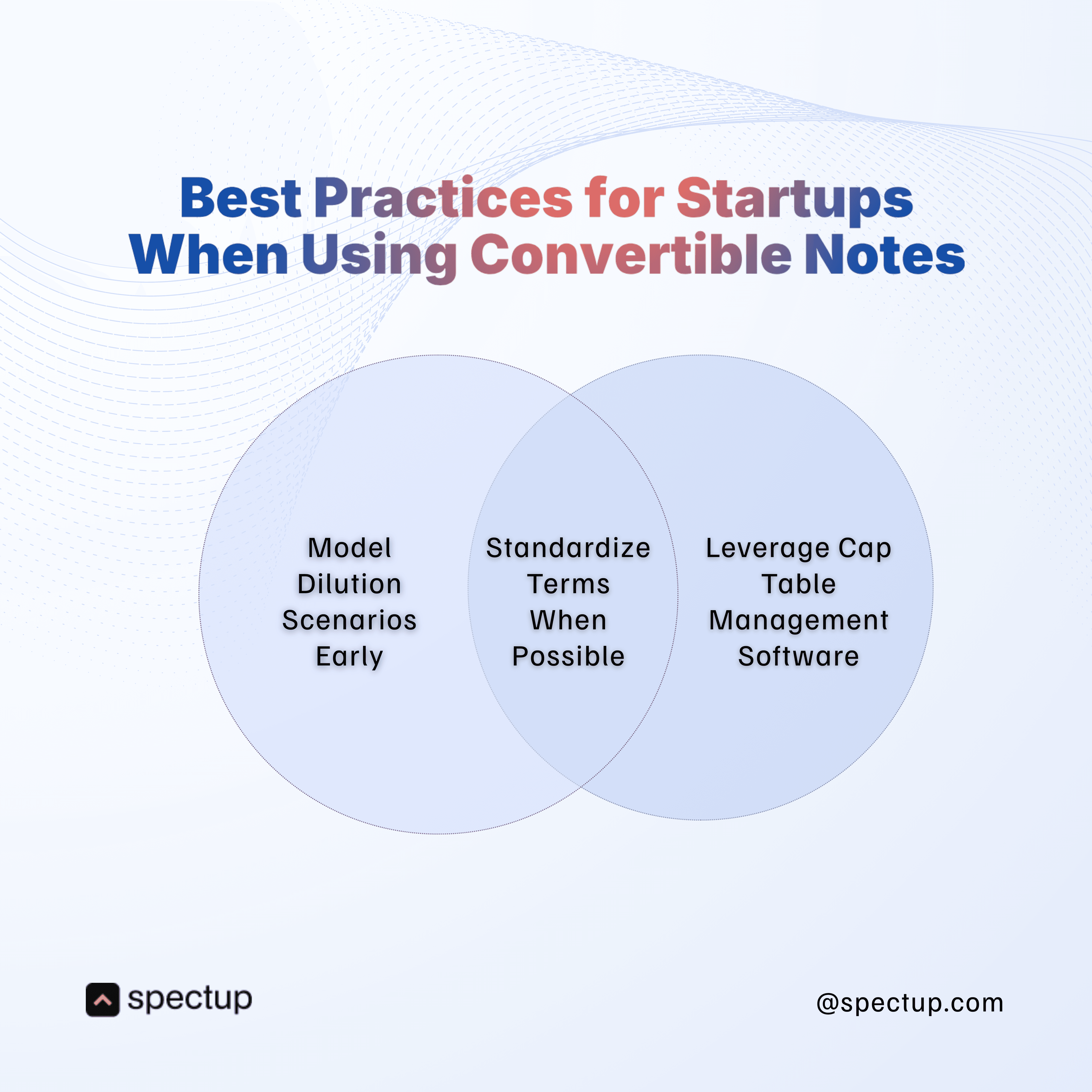
A comprehensive understanding of how convertible notes impact the capitalization table is essential for making informed decisions regarding fundraising strategies and preserving control over the distribution of equity within a startup. Such clarity also facilitates more effective discussions with investors during subsequent financing rounds.
When Should Startups Use Convertible Notes?
Choosing between a convertible note vs SAFE (Simple Agreement for Future Equity), or alternative early-stage funding instruments can present significant challenges for founders. Understanding the differences in structure and implications of a convertible note vs SAFE is essential. A clear understanding of how convertible notes operate within the context of your specific business circumstances is crucial for informed decision-making. While convertible notes may provide advantages to certain startups, they may prove suboptimal if their timing or financial terms do not align with the company’s strategic objectives or capital requirements.
Ideal Scenarios:
Pre-seed or seed rounds before valuation clarity: When it’s tough to pin down a fair company valuation, convertible notes let you raise capital without getting stuck in valuation debates. Investors get protection through caps and discounts, while you keep things moving.
Bridge rounds between priced equity rounds: If you need funds to keep going until your next big funding event, convertible debt funding provides a quick cash injection without the complexity of setting share prices immediately.
When speed and low cost of fundraising matter most: Compared to priced equity rounds, convertible notes are faster and cheaper to execute, perfect for startups eager to focus on growth instead of paperwork.
Situations to Avoid:
Startups with uncertain timelines for the next round: Convertible notes usually have maturity dates that pressure you to raise again or repay. If your next round’s timing is fuzzy, you might face uncomfortable repayment demands or forced conversions.
Companies unable to handle potential repayment pressure: Since convertible notes start as debt, failing to convert means paying back principal plus interest, a heavy burden if cash flow is tight.
Founders uncomfortable with compounding dilution risk: Interest accrual and multiple note rounds can dilute your ownership more than expected, especially if you haven’t modeled your convertible note cap table carefully.
Knowing when convertible notes fit your startup’s story helps avoid surprises and positions you for smarter fundraising moves.
Conclusion
Convertible notes are a flexible, efficient tool for early-stage funding, especially in startups. Understanding their debt structure and equity conversion helps founders make informed decisions to protect strategic vision and growth. Knowing how convertible notes affect the cap table is key to anticipating dilution and maintaining control.
Choosing between convertible note vs SAFE depends on startup needs and investor expectations. Convertible notes offer interest rates and maturity dates for greater investor protection, while SAFEs prioritize simplicity and speed but lack some safeguards. The right choice lays the groundwork for future fundraising.
If you're unsure about funding structures or legal and financial complexities, spectup offers expert guidance tailored to startups, simplifying instruments like convertible notes and SAFEs so you can focus on growing your business.
Niclas Schlopsna
Partner
Ex-banker, drove scale at N26, launched new ventures at Deloitte, and built from scratch across three startup ecosystems.







